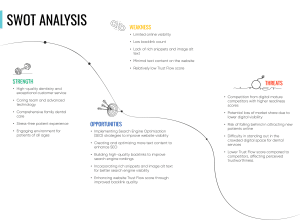What is a SWOT Analysis?
A SWOT analysis is a crucial tool for small businesses to identify strengths, weaknesses, opportunities, and threats. Fortunately, there are many tools available to help you perform a comprehensive SWOT analysis. Keep reading for a list of some of the most common tools used to create an analysis. These tools offer a range of features, including customizable templates, collaboration capabilities, and data visualization options. By using these tools, you can streamline your SWOT analysis process, gain valuable insights, and make informed business decisions.
The Importance of a SWOT Analysis in the Growth and Development of a Small Business
In the digital marketing sphere, it’s critical for sales representatives to comprehend the stance of a small business within its respective market. One practical and strategic method to accomplish this is through a SWOT (Strengths, Weaknesses, Opportunities, Threats) analysis.
The SWOT analysis of a small business can guide a digital marketing agency through the complexities of the business environment. It provides an all-encompassing view of where a small business thrives, its shortcomings, growth potentials, and the threats to its operations.
For instance, prospecting can be sharpened and enhanced through SWOT analysis, serving to highlight the unique selling points of a small business. This clarity allows a digital marketing agency to intensify these strengths. Furthermore, weak areas can be identified, pushing for strategic adjustments to address these areas.
The SWOT analysis also uncovers external factors—revealing hidden opportunities within the local market or shedding light on looming threats. This helps in the strategic foresight and planning for small businesses.
Incorporating a SWOT analysis in their work is fundamental for sales representatives. The tool aids internal decision-making and provides clients with an effective overall evaluation instrument. By dissecting the crucial elements of a SWOT analysis, a digital marketing agency can collaborate with businesses to stimulate growth and development.
Whether prospecting or strategizing, a SWOT analysis provides imperative insights for small businesses. Seize the opportunity and delve into the realm of SWOT.
Different Tools Available for Conducting a Detailed Small Business SWOT Analysis
Understanding a small business’s strengths, weaknesses, opportunities, and threats, commonly known as a SWOT analysis, is crucial for any digital marketing agency. Thankfully, there are many tools available to streamline this process.
Take Trello, a popular project management platform. It can be used to organize and visualize a small business’s SWOT analysis. With Trello, users can create individual cards for each aspect of the SWOT analysis, providing a clear picture of a business’s position.
Another valuable tool is Canva. It features pre-designed templates specifically for conducting digital SWOT analyses. Canva’s effortless drag-and-drop interface allows users to create easy-to-understand visuals that effectively illustrate a small business’s status.
Swot.com, a free online SWOT analysis tool, offers prompts for every component of the SWOT analysis, streamlining the process even further.
For teams, a tool like Slack is indispensable. Its customizable channel feature can be used to categorize different aspects of the SWOT analysis and facilitate discussions.
Google Analytics is also recommended, especially for data-driven businesses. This dynamic tool aids in assessing online performance related to opportunities and threats.
And, of course, BuzzBoard provides push-button generation of AI-powered SWOT analysis for small, local and mid-sized businesses.

By learning to use these tools effectively, a digital marketing agency can gain crucial insights and set the stage for productive strategies.
How a Digital Marketing Agency Can Assist a Small Business in Conducting a SWOT Analysis
Conducting a comprehensive SWOT analysis is a crucial step in helping a small business achieve success, and a digital marketing agency can play a vital role in this process. SWOT, an acronym for Strengths, Weaknesses, Opportunities, and Threats, provides a detailed overview of the business’s current status, identifying areas of improvement, potential growth, and potential obstacles. By executing a robust SWOT analysis, a digital marketing agency can help a small business gain a deeper understanding of its internal and external environment, enabling informed decision-making and strategic planning.
To conduct an effective SWOT analysis, a digital marketing agency begins by identifying the business’s strengths, which are the key elements that set it apart from its competitors and provide a competitive edge. This includes the business’s unique selling proposition, its resources, and its capabilities. For instance, a small business may have a talented team, a strong brand reputation, or a unique product or service that sets it apart from others in the industry. Identifying these strengths is essential in understanding what the business does well and how it can leverage these strengths to achieve its goals.
Next, the agency focuses on identifying the business’s weaknesses, which are the areas that require improvement or attention. These weaknesses may include internal factors such as inadequate resources, inefficient processes, or a lack of expertise, as well as external factors such as market trends, consumer behavior, or competitor activity. By acknowledging these weaknesses, a business can develop strategies to overcome these challenges and improve its overall performance.
Following the identification of strengths and weaknesses, the agency shifts its focus to opportunities, which are the potential areas for growth or advancement. This includes identifying emerging trends, consumer behavior, and market shifts that the business can capitalize on. For instance, a small business may identify an opportunity to expand its product or service offerings, enter a new market, or leverage social media to reach a wider audience. By recognizing these opportunities, a business can develop strategies to capitalize on them and drive growth.
Finally, the agency evaluates potential threats that the business may encounter, which can include market trends, economic downturns, competitors’ actions, or changes in regulations. By identifying these threats, a business can develop strategies to mitigate them and minimize their impact. For instance, a small business may identify a threat from a new competitor entering the market and develop a strategy to differentiate itself and maintain its market share.
Through careful analysis of these elements, a digital marketing agency can provide vital insights to propel business growth. By developing tailored marketing strategies that focus on leveraging strengths, addressing weaknesses, capitalizing on opportunities, and mitigating threats, a digital marketing agency can help a small business achieve its goals and achieve success.
The Role of Prospecting and Analyzing in Performance of a Small Business SWOT Analysis
In the realm of digital marketing, personnel within agencies are consistently striving to improve performance for their small business clientele. Essential to this goal is the process of prospecting and analysis, which forms the foundation of any small business SWOT analysis.
Prospecting involves identifying potential clients or customers. In terms of a digital marketing agency, this concept translates to pinpointing small businesses that could benefit from their services. The subsequent stage of analysis evaluates these prospective clients. It is an in-depth exploration of their strengths, weaknesses, opportunities, and threats, which essentially molds the framework for a SWOT analysis.
For small businesses, a SWOT analysis is invaluable for emphasizing their unique value proposition and securing a distinctive position in a competitive market. This review process offers agencies excellent insight into a client’s internal operations, known strengths, and weaknesses, as well as external factors like potential opportunities and looming threats.
Strengths can include factors such as singular products or exceptional services, whereas weaknesses may refer to constraints like a limited budget. External opportunities might include untapped markets, and threats can indicate rising competition within their established markets. Understanding these aspects helps tailor the marketing strategies to suit the client’s specific requirements and capabilities.
In conclusion, the role of prospecting and analysis in conducting a small business SWOT analysis is key to achieving success. It creates a strategic roadmap, shaping the marketing initiatives that boost client growth and business sustenance.
An Example Showcasing a Small Business Successfully Implementing Changes After a SWOT Analysis
Consider the incredible success story of a small bakery in Phoenix, Arizona. The bakery’s immense potential came to light after a well-conducted SWOT (Strengths, Weaknesses, Opportunities, Threats) analysis performed by a digital marketing agency.
The agency executed a comprehensive analysis, examining the bakery’s strengths and weaknesses relative to local competitors. It also identified opportunities and threats from both the local and broader market.
The bakery’s strengths were clear. A loyal customer base, a wide variety of quality goods, and a prime location. However, the weaknesses were apparent as well, notably an underused social media presence and a nonexistent online footprint.
Following the analysis, opportunities were identified to maximize social media use, expand delivery services, and diversify product offerings. The threats were a soon-to-be-opened competing bakery and escalating raw materials prices.
Action steps were outlined after the SWOT analysis. The bakery refreshed and relaunched their social media platforms, introduced online ordering, and amplified delivery service promotion. To combat the looming competition, a loyalty rewards program was implemented. They also cut down on waste and refined resource management to manage rising costs.
These changes drove an uptick in foot traffic, retained over 50% of the customer base, and substantially boosted online sales.
This example underscores the critical role a SWOT analysis plays in steering small businesses toward success. As sales representatives in digital marketing agencies, using SWOT analysis can enhance your prospecting strategy when engaging potential small business clients.









